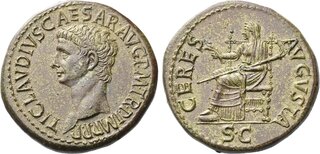| Numismatica Ars Classica > Auction 144 with CNG & NGSA | Auction date: 8 May 2024 |
| Lot number: 1027 Price realized: This lot is for sale in an upcoming auction - Bid on this lot  | Show similar lots on CoinArchives Find similar lots in upcoming auctions on |
| Lot description: The Geoffrey Cope Collection of Ancient Greek and Roman Bronzes. The Roman Empire. Claudius augustus, 41 – 54. Description Dupondius, Roma circa 50-54, Æ 30 mm, 18.21 g. TI CLAVDIVS CAESAR AVG P M TR P IMP P P Bare head l. Rev. CERES – AVGVSTA Ceres, veiled and draped, seated l. holding ear of corns and long torch; in exergue, S C. Reference C 1 BMC 197 RIC 110 CBN 222 Condition A bold portrait of great elegance struck on a full flan and with an untouched olive-green patina. Good extremely fine Provenance NAC sale 40, 2007, 661 NAC sale 84, 2015, 920 Note: : The reverse of this dupondius features Ceres, the Roman goddess of agriculture and grain. She had long been a deity of great concern to the growing numbers of the urban poor in Rome since the late Republican period. Since mobs of hungry citizens posed a real threat to the stability of the imperial capital, periodic attempts were made to ensure access to grain for the most vulnerable. To this end, Augustus expanded the grain dole known as the annona to feed about 200,000 citizens in a city with an estimated population of 450,000 people, but this did little to curb prices for those who did meet the poverty requirements of the annona. Public outcry over the skyrocketing prices of grain in the early Julio-Claudian period led to the introduction of emergency measures, such as rationing and expulsion of parts of the non-citizen populace under Augustus and the setting of maximum prices and subsidies to grain dealers under Tiberius. When the same problems caused such severe disturbances under Claudius that the emperor was pelted with crusts of bread while walking through the Forum, he determined that a long-term solution was needed for the supply of grain to Rome at reasonable cost. Since grain prices in the Eternal City invariably increased in times of scarcity, particularly in the winter months, Claudius arranged for subventions to grain merchants in order to guarantee regular shipments of grain to Rome during the winter as well as in the traditional summer sailing season. In this way he ensured that grain was always in good supply and therefore less subject to price gouging. The emperor supported this measure by constructing a large new harbour facility at Portus near Rome's traditional port at Ostia. Portus served the expanded grain fleet necessitated by the new policy of year-round shipping and also protected the fleet while in the harbour. Ostia was notorious for its lack of protection from storms. By placing Ceres on the reverse of this coin, Claudius was advertising that he had received the message of the bread crusts and was taking action. In future, citizens could expect the bounty of the goddess to be more consistently available to them and at acceptable prices. Estimate: 20000 CHF |  |



